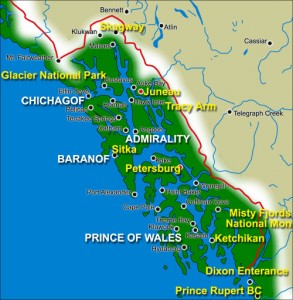The U.S. Forest Service has decided to make changes in its Tongass land management plan. That means users and interest groups will get to submit suggestions on road-building, logging, stream restoration and habitat protection.
The decision is no surprise to anyone who follows Tongass politics.
The Forest Service is required to consider opening the plan for changes every five years. It usually does, but can choose to leave the document as it is.
Agency offices are closed due to the federal government shutdown. So, no one was available to discuss the decision, described in a press release issued just before furloughs.
The lengthy process concerns both advocates and critics of the way the Tongass is managed.
“Once you open a plan and start changing a plan, everything comes to a screeching halt,” Shelly Wright, the executive director of the Southeast Conference – which supports more logging and mining in the Tongass, said.
The organization released its own Tongass management plan last month, which would remove some forest protections and allow more old-growth logging.
“There is a silver lining, we hope, that the Forest Service will open their minds and their planning books and take a look at our strategy,” Wright said. “(It’s) a strategy that we feel is a good strategy for the environment and the economics and the social and cultural environment in Southeast Alaska.”
 Austin Williams is Alaska forest program manager for Trout Unlimited, which advocates protection and restoration of Tongass fish habitat.
Austin Williams is Alaska forest program manager for Trout Unlimited, which advocates protection and restoration of Tongass fish habitat.
“You know, it’s hard to conclude that the Forest Service is making good on its promise to rapidly transition out of old-growth logging,” Williams said.
The group worries agency managers have set up too many timber sales in mature forests.
Williams says that costs the government too much. He says the agency should do more to support the growing fishing and tourism industries.
“There’s really an opportunity right now for the Forest Service to help Southeast Alaska take advantage of this momentum and really start investing in the areas that really benefit Southeast Alaska,” he said.
The logging industry says it would be in better shape if it could access the timber promised in the current plan.
Owen Graham, executive director of the Alaska Forest Association, says mills and loggers have only gotten 20 percent of what was promised.
“We weren’t seeking a huge increase; we’d like to see a small increase in the amount of volume from what they had in TLMP,
but more than that, we want them to actually make changes so they can implement the plan,” Graham said. “But they can’t implement the plan they have, so simply reducing the volume to 20 percent of what it was isn’t a solution either.”
A Forest Service press release says plan modification, “is expected to focus on identifying the timber base suitable to support a transition to young-growth management.”
Trout Unlimited’s Williams supports the change from old to young growth.
“We have some concerns the transition is dragging out longer than it needs to,” he said. “But we are encouraged that the Forest Service is at least trying to move away from the large-scale, old-growth sales and into young growth and other kinds of projects.”
Tongass officials have already received numerous suggestions about changing its management plan. Those came during the process of deciding to open up that document.
In a September interview, before the government shut down, Tongass Supervisor Forrest Cole said he expected a lot more input.
“I believe over the life of the current forest plan, we’ve probably looked at 30 or 40 different alternatives,” he said. “And I’m guessing that we’ll look at a wide variety again. “
The Forest Service’s press release did not include a comment deadline, meeting schedule or overall timeline. And, due to the shutdown, no one could speak to those details.
Ed Schoenfeld is Regional News Director for CoastAlaska, a consortium of public radio stations in Ketchikan, Juneau, Sitka, Petersburg and Wrangell.
He primarily covers Southeast Alaska regional topics, including the state ferry system, transboundary mining, the Tongass National Forest and Native corporations and issues.
He has also worked as a manager, editor and reporter for the Juneau Empire newspaper and Juneau public radio station KTOO. He’s also reported for commercial station KINY in Juneau and public stations KPFA in Berkley, WYSO in Yellow Springs, Ohio, and WUHY in Philadelphia. He’s lived in Alaska since 1979 and is a contributor to Alaska Public Radio Network newscasts, the Northwest (Public Radio) News Network and National Native News. He is a board member of the Alaska Press Club. Originally from Cleveland, Ohio, he lives in Douglas.




